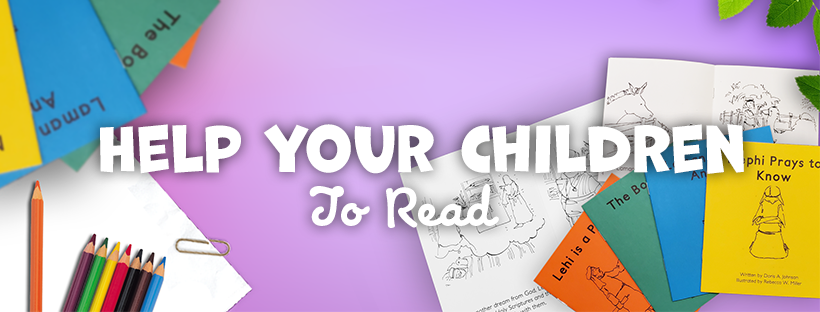
SIMILAR POSTS

Will They Accept My Gift – The Creation of Picture Pages
Each day I knelt in prayer and sought to understand scriptural meaning during my personal scripture study time. After reading a few verses that seemed to go together, I wrote a child friendly description to inspire the drawing of a picture—after my children’s “manner of language that [my children] might come to understanding.” (D&C 1:24)
RECOMMENDED
No Results Found
The page you requested could not be found. Try refining your search, or use the navigation above to locate the post.
Perfect for Homeschoolers // How can I help my children read?

When teaching a young child to read there are always questions:
- Which reading materials shall I use?
- How can I know if my child is ready to move to more difficult materials?
- How can I know if my teaching methods are best practices?
- Which reading materials shall I use?
Homeschoolers that are members of The Church of Jesus Christ of Latter-day Saints most likely love the Book of Mormon and want their children to love it too. The text in the actual Book of Mormon is too difficult for a child that is just learning to read.
Why are Book of Mormon Little Books perfect for homeschoolers?
- The Book of Mormon Little Books give children a jumpstart in learning to read the actual Book of Mormon. All of Lehi’s family members are introduced in Levels A, B, and C, which are realistic fiction—things that could have happened in Lehi’s family. The young child identifies with these happenings.
- Direct correspondence between the text and the pictures, patterns, repetition, and consistent text format—all important for beginners—appear in these beginning levels.
- The small size of the book, repetitious words in the script, and seeing pictures that go with the words develop a sense of ownership and self-confidence in young readers.
- Levels D, E, and F are scripturally accurate and scripturally referenced for each book. Quotes from the Book of Mormon are footnoted on pages where they are used.
- While reading and re-reading the 32 books, children will acquire an appreciation and love for the Book of Mormon characters and stories. Lasting impressions will be with them as they continue to learn gospel truths throughout their lives.
- How can I know if my child is ready to move to more difficult reading materials?
To decide if a child is ready to move on to more difficult reading materials the parent must understand the meaning of instructional level. Often parents, as well as teachers, give children reading material that is too difficult, which causes discouragement rather than a love for reading.
Simply, a comfortable instructional level is between 90-94% accuracy. How is that figured? Have a child read 100 words in a text. The number of words they accurately read is their accuracy %. If they can only read 80/100 words their accuracy level is 80%, and the text is too difficult to be used for instruction. A more simple way to figure this is to divide the total number of words read correctly the by total word count in a book. For example, if the child read 28/32 words correctly, divide 28 by 32 and the accuracy would be .875 or 87.5%. When a children can read at 95% accuracy they are ready to read more difficult materials.
Why are Book of Mormon Little Books perfect for homeschoolers?
- Because the math is already done! Total word count and the 95% accuracy level are printed on the back of each book. A beginner should fluently read each book with 95% accuracy level before moving on to the next book.
- How can I know if my teaching methods are best practices?
Many homeschoolers are being educated about teaching as-they-go and often desire to learn effective instructional practices. Where do they turn? How can they actually teach with best practices?
Why are Book of Mormon Little Books perfect for homeschoolers?
- Because Book of Mormon Little Books can be used as supplementary learn-to-read books in conjunction with the book named Scripted Lesson Plans: Book of Mormon Little Books, which includes 32 lessons, one for each of the little books. These lessons are written according to Scientifically Based Reading Research (SBRR). www.nationalreadingpanel.org
- Every lesson includes THE BIG 5, which are the five critical areas of teaching children to read: Phonemic Awareness, Phonics and Word Study, Fluency, Vocabulary and Comprehension. www.nationalreadingpanel.org
- The lessons are written with “Direct Explicit Systematic Instruction.” This is the I DO—WE DO—YOU DO instructional method, and is scripted so the parent-teacher knows what to say, and knows possible student responses.
–I DO: The teacher models how to do the skill.
–WE DO: The teacher and the student do the skill together.
–YOU DO The student independently practices the skill.
In summary, the 32 Book of Mormon Little Books in conjunction with the 32 scripted lesson plans have been a great help to many parents in teaching their children to read. Please go to www.bookofmormonlittlebooks.com for more information.

Doris Johnson
Founder, Book of Mormon Little Books
I have taught all grades K-6 for over 25 years in the public schools in California and Arizona. I served as an Arizona State Reading Specialist, consulting with principals, reading coaches, and teachers to support the implementation of Scientifically Based Reading Research practices. My Master of Education degree emphasized teaching children to read and write. I used a unique method of teaching my own five children the scriptures by preparing 2,241 Book of Mormon Picture Pages. Now, I’m retired and teach my grandchildren with these materials.